# import libraries
import pandas as pd
import numpy as np
import seaborn as sns
from matplotlib import pyplot as plt
import matplotlib as mpl
from sklearn import metrics
from sklearn.metrics import confusion_matrix
from sklearn.metrics import ConfusionMatrixDisplay
from sklearn.model_selection import train_test_split
from sklearn.naive_bayes import MultinomialNB
from sklearn.neural_network import MLPClassifier
from sklearn.ensemble import RandomForestClassifier
from sklearn.feature_extraction.text import CountVectorizer
from sklearn.feature_extraction.text import TfidfVectorizer
# change this to your own data directory
data_dir = "data/"
# read and preprocess data
text_file_name = "osdg-community-data-v2023-01-01.csv"
text_df = pd.read_csv(data_dir + text_file_name,sep = "\t", quotechar='"')
col_names = text_df.columns.values[0].split('\t')
text_df[col_names] = text_df[text_df.columns.values[0]].apply(lambda x: pd.Series(str(x).split("\t")))
text_df = text_df.astype({'sdg':int, 'labels_negative': int, 'labels_positive':int, 'agreement': float}, copy=True)
text_df.drop(text_df.columns.values[0], axis=1, inplace=True)
text_df = text_df.query("agreement > 0.5 and (labels_positive - labels_negative) > 2")
text_df.reset_index(inplace=True, drop=True)
docs = text_df.text
categories = text_df.sdg
X_train, X_test, y_train, y_test = \
train_test_split(docs, categories, test_size=0.33, random_state=7)
14.9. Solutions to Exercises: Sections 5 to 7#
14.9.1. Classification of Texts#
For exercises 1 to 3, the below code will be used to establish the dataset used for all next classifications.
X_train_tfidf_vectorizer = TfidfVectorizer(ngram_range=(1,1), stop_words = "english", min_df=5)
X_train_tfidf_vectorizer.fit(X_train)
X_train_tfidf_vector = X_train_tfidf_vectorizer.transform(X_train)
X_test_tfidf_vector = X_train_tfidf_vectorizer.transform(X_test)
Exercise 1
tfidf_mlp_clf = MLPClassifier(random_state=1, max_iter=100).fit(X_train_tfidf_vector, y_train)
y_pred = tfidf_mlp_clf.predict(X_test_tfidf_vector)
tfidf_mlp_clf.score(X_test_tfidf_vector, y_test)
print(metrics.classification_report(y_test,y_pred))
precision recall f1-score support
1 0.79 0.81 0.80 481
2 0.82 0.87 0.84 316
3 0.94 0.93 0.94 674
4 0.92 0.94 0.93 863
5 0.92 0.92 0.92 920
6 0.90 0.91 0.91 465
7 0.88 0.88 0.88 730
8 0.68 0.61 0.64 353
9 0.79 0.80 0.79 328
10 0.64 0.58 0.61 256
11 0.85 0.88 0.86 462
12 0.85 0.78 0.81 217
13 0.85 0.87 0.86 443
14 0.93 0.92 0.93 263
15 0.89 0.85 0.87 313
16 0.97 0.97 0.97 1057
accuracy 0.88 8141
macro avg 0.85 0.85 0.85 8141
weighted avg 0.88 0.88 0.88 8141
Exercise 2
tfidf_multinomialNB_clf = MultinomialNB().fit(X_train_tfidf_vector, y_train)
y_pred = tfidf_multinomialNB_clf.predict(X_test_tfidf_vector)
print(metrics.classification_report(y_test,y_pred))
precision recall f1-score support
1 0.70 0.73 0.71 481
2 0.90 0.67 0.77 316
3 0.92 0.90 0.91 674
4 0.76 0.96 0.85 863
5 0.62 0.94 0.75 920
6 0.86 0.81 0.84 465
7 0.60 0.97 0.74 730
8 0.85 0.08 0.15 353
9 0.91 0.32 0.48 328
10 0.89 0.12 0.21 256
11 0.86 0.75 0.80 462
12 0.97 0.30 0.46 217
13 0.84 0.80 0.82 443
14 0.96 0.61 0.75 263
15 0.96 0.64 0.77 313
16 0.86 0.98 0.91 1057
accuracy 0.77 8141
macro avg 0.84 0.66 0.68 8141
weighted avg 0.81 0.77 0.74 8141
Exercise 3
from sklearn.linear_model import RidgeClassifier
tfidf_ridge_clf = RidgeClassifier(tol=1e-2, solver="sparse_cg")
tfidf_ridge_clf = tfidf_ridge_clf.fit(X_train_tfidf_vector, y_train)
y_pred = tfidf_ridge_clf.predict(X_test_tfidf_vector)
print(metrics.classification_report(y_test,y_pred, digits = 4))
precision recall f1-score support
1 0.8174 0.8004 0.8088 481
2 0.8192 0.8892 0.8528 316
3 0.9294 0.9377 0.9335 674
4 0.9109 0.9594 0.9345 863
5 0.9092 0.9467 0.9276 920
6 0.9188 0.9247 0.9218 465
7 0.8714 0.9096 0.8901 730
8 0.7186 0.6006 0.6543 353
9 0.8233 0.7957 0.8093 328
10 0.6990 0.5625 0.6234 256
11 0.8690 0.8615 0.8652 462
12 0.8836 0.7696 0.8227 217
13 0.8521 0.8713 0.8616 443
14 0.9423 0.9316 0.9369 263
15 0.9112 0.8850 0.8979 313
16 0.9513 0.9612 0.9562 1057
accuracy 0.8840 8141
macro avg 0.8642 0.8504 0.8560 8141
weighted avg 0.8815 0.8840 0.8820 8141
Exercise 4
Implementations may vary. One example is given below:
def ClassifyDocs(data, classifier_algorithm, params):
docs = data.text
categories = data.sdg
X_train, X_test, y_train, y_test = train_test_split(docs, categories, test_size=0.33, random_state=7)
X_train_tfidf_vectorizer = TfidfVectorizer(ngram_range=(1,1), stop_words = "english", min_df=5)
X_train_tfidf_vectorizer.fit(X_train)
X_train_tfidf_vector = X_train_tfidf_vectorizer.transform(X_train)
X_test_tfidf_vector = X_train_tfidf_vectorizer.transform(X_test)
if classifier_algorithm == "mlp":
tfidf_mlp_clf = MLPClassifier(random_state=params[0], max_iter=params[1]).fit(X_train_tfidf_vector, y_train)
y_pred = tfidf_mlp_clf.predict(X_test_tfidf_vector)
tfidf_mlp_clf.score(X_test_tfidf_vector, y_test)
print(metrics.classification_report(y_test,y_pred))
elif classifier_algorithm == "multinomialNB":
tfidf_multinomialNB_clf = MultinomialNB().fit(X_train_tfidf_vector, y_train)
y_pred = tfidf_multinomialNB_clf.predict(X_test_tfidf_vector)
print(metrics.classification_report(y_test,y_pred))
elif classifier_algorithm == "ridge":
tfidf_ridge_clf = RidgeClassifier(tol=params[0], solver=params[1])
tfidf_ridge_clf = tfidf_ridge_clf.fit(X_train_tfidf_vector, y_train)
y_pred = tfidf_ridge_clf.predict(X_test_tfidf_vector)
print(metrics.classification_report(y_test,y_pred, digits = 4))
else:
print("Invalid classifier algorithm")
Exercise 5
print("MLP")
ClassifyDocs(text_df, "mlp", [1,100])
print("MultinomialNB")
ClassifyDocs(text_df, "multinomialNB", [])
print("Ridge")
class_params = [1e-2, "sparse_cg"]
ClassifyDocs(text_df, "ridge", class_params)
MLP
precision recall f1-score support
1 0.79 0.81 0.80 481
2 0.82 0.87 0.84 316
3 0.94 0.93 0.94 674
4 0.92 0.94 0.93 863
5 0.92 0.92 0.92 920
6 0.90 0.91 0.91 465
7 0.88 0.88 0.88 730
8 0.68 0.61 0.64 353
9 0.79 0.80 0.79 328
10 0.64 0.58 0.61 256
11 0.85 0.88 0.86 462
12 0.85 0.78 0.81 217
13 0.85 0.87 0.86 443
14 0.93 0.92 0.93 263
15 0.89 0.85 0.87 313
16 0.97 0.97 0.97 1057
accuracy 0.88 8141
macro avg 0.85 0.85 0.85 8141
weighted avg 0.88 0.88 0.88 8141
MultinomialNB
precision recall f1-score support
1 0.70 0.73 0.71 481
2 0.90 0.67 0.77 316
3 0.92 0.90 0.91 674
4 0.76 0.96 0.85 863
5 0.62 0.94 0.75 920
6 0.86 0.81 0.84 465
7 0.60 0.97 0.74 730
8 0.85 0.08 0.15 353
9 0.91 0.32 0.48 328
10 0.89 0.12 0.21 256
11 0.86 0.75 0.80 462
12 0.97 0.30 0.46 217
13 0.84 0.80 0.82 443
14 0.96 0.61 0.75 263
15 0.96 0.64 0.77 313
16 0.86 0.98 0.91 1057
accuracy 0.77 8141
macro avg 0.84 0.66 0.68 8141
weighted avg 0.81 0.77 0.74 8141
Ridge
precision recall f1-score support
1 0.8174 0.8004 0.8088 481
2 0.8192 0.8892 0.8528 316
3 0.9294 0.9377 0.9335 674
4 0.9109 0.9594 0.9345 863
5 0.9092 0.9467 0.9276 920
6 0.9188 0.9247 0.9218 465
7 0.8714 0.9096 0.8901 730
8 0.7186 0.6006 0.6543 353
9 0.8233 0.7957 0.8093 328
10 0.6990 0.5625 0.6234 256
11 0.8690 0.8615 0.8652 462
12 0.8836 0.7696 0.8227 217
13 0.8521 0.8713 0.8616 443
14 0.9423 0.9316 0.9369 263
15 0.9112 0.8850 0.8979 313
16 0.9513 0.9612 0.9562 1057
accuracy 0.8840 8141
macro avg 0.8642 0.8504 0.8560 8141
weighted avg 0.8815 0.8840 0.8820 8141
14.9.2. Evaluating Classification#
Exercise 1
First, we do the prep needed before making the ROC curve:
from sklearn import preprocessing
from sklearn.multiclass import OneVsRestClassifier
from sklearn.preprocessing import LabelBinarizer
import tensorflow as tf
import tensorflow_hub as hub
# change this to your own embedding directory
embedding_dir = ""
# load the embedding
embed = hub.load(embedding_dir + "universal-sentence-encoder_4")
text_df["embedding"] = list(embed(text_df.text))
file_name = "sdg_names_definitions.csv"
sdg_names = pd.read_csv(data_dir + file_name)
docs = text_df.embedding.tolist()
scaler = preprocessing.MinMaxScaler().fit(docs)
X = scaler.transform(docs)
y = text_df.sdg
label_binarizer = LabelBinarizer().fit(y)
y_onehot = label_binarizer.transform(y)
n_classes = len(label_binarizer.classes_)
class_names = [sdg_names[sdg_names["sdg"] == label_binarizer.classes_[i]].sdg_name.item() \
for i in range(n_classes)]
2024-07-12 16:12:25.149972: I tensorflow/core/common_runtime/executor.cc:1197] [/device:CPU:0] (DEBUG INFO) Executor start aborting (this does not indicate an error and you can ignore this message): INVALID_ARGUMENT: You must feed a value for placeholder tensor 'inputs' with dtype string
[[{{node inputs}}]]
Then, we can make the curve itself. First for the Naive Bayes classification:
X_train, X_test, y_train, y_test = train_test_split(X, y_onehot, test_size=.33, random_state=0)
ovr_nb_clf = OneVsRestClassifier(MultinomialNB()).fit(X_train,y_train)
y_score_nb = ovr_nb_clf.predict_proba(X_test)
from matplotlib import cm
colors = list(cm.get_cmap('tab20').colors)
fpr = dict()
tpr = dict()
roc_auc = dict()
for class_id in range(n_classes):
fpr[class_id], tpr[class_id], _ = metrics.roc_curve(y_test[:, class_id], y_score_nb[:, class_id]) # roc_curve works on binary
roc_auc[class_id] = metrics.auc(fpr[class_id], tpr[class_id])
for class_id, color in zip(range(n_classes), colors):
plt.plot(fpr[class_id], tpr[class_id], color=color, lw=1.5,alpha = 1,
label='SDG {0} - {1} (AUC = {2:0.2f})'
''.format(class_id+1, class_names[class_id], roc_auc[class_id]))
plt.plot([0, 1], [0, 1], '--', lw=1, color="lightgrey")
plt.xlim([-0.05, 1.0])
plt.ylim([0.0, 1.05])
plt.xlabel('False Positive Rate')
plt.ylabel('True Positive Rate')
plt.title('ROC for SDG multiclass classifier')
plt.legend(loc="lower right", fontsize=6)
plt.show()
/var/folders/px/b7vc3nh913zb_m0x36ncftj00000gn/T/ipykernel_86574/1881487763.py:2: MatplotlibDeprecationWarning: The get_cmap function was deprecated in Matplotlib 3.7 and will be removed two minor releases later. Use ``matplotlib.colormaps[name]`` or ``matplotlib.colormaps.get_cmap(obj)`` instead.
colors = list(cm.get_cmap('tab20').colors)
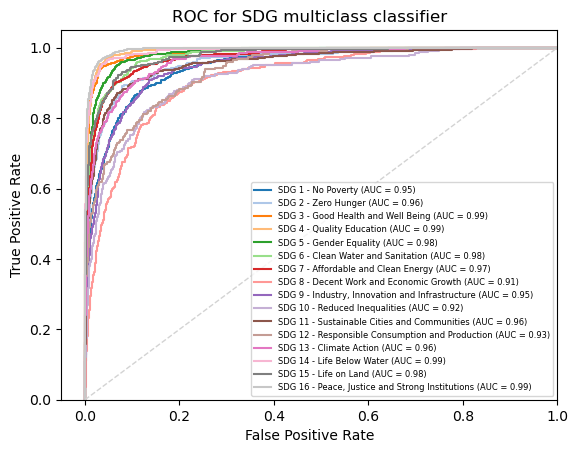
And then for the Ridge classification:
ovr_ridge_clf = OneVsRestClassifier(RidgeClassifier(tol=1e-2, solver="sparse_cg")).fit(X_train,y_train)
y_score_ridge = ovr_ridge_clf.predict(X_test)
fpr = dict()
tpr = dict()
roc_auc = dict()
for class_id in range(n_classes):
fpr[class_id], tpr[class_id], _ = metrics.roc_curve(y_test[:, class_id], y_score_ridge[:, class_id]) # roc_curve works on binary
roc_auc[class_id] = metrics.auc(fpr[class_id], tpr[class_id])
for class_id, color in zip(range(n_classes), colors):
plt.plot(fpr[class_id], tpr[class_id], color=color, lw=1.5,alpha = 1,
label='SDG {0} - {1} (AUC = {2:0.2f})'
''.format(class_id+1, class_names[class_id], roc_auc[class_id]))
plt.plot([0, 1], [0, 1], '--', lw=1, color="lightgrey")
plt.xlim([-0.05, 1.0])
plt.ylim([0.0, 1.05])
plt.xlabel('False Positive Rate')
plt.ylabel('True Positive Rate')
plt.title('ROC for SDG multiclass classifier')
plt.legend(loc="lower right", fontsize=6)
plt.show()
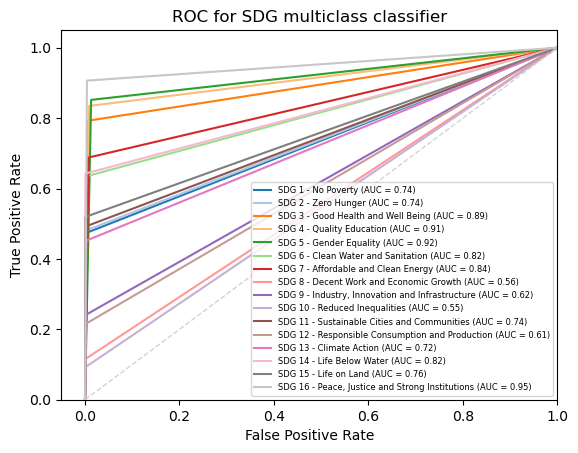
When students are making the plot for ridge regression, they will likely notice that ridge classifiers do not have a predict_proba method. Feel free to encourage students to look to other resources for overcoming this problem. Alternatively, ask them why they might think this is the case - the reason for this is because ridge regression does not calculate probabilities for its results in its basic form but must rather interpret the assigned values from the regression into some sort of probability, which it does not do by default.
Exercise 2
Answers may vary depending on the chosen goals but should follow the example given in the chapter.
Exercise 3
First, we perform the classification:
docs = text_df.embedding.tolist()
scaler = preprocessing.MinMaxScaler().fit(docs)
X = scaler.transform(docs)
y = text_df.sdg
label_binarizer = LabelBinarizer().fit(y)
y_onehot = label_binarizer.transform(y)
n_classes = len(label_binarizer.classes_)
class_names = [sdg_names[sdg_names["sdg"] == label_binarizer.classes_[i]].sdg_name.item() \
for i in range(n_classes)]
X_train, X_test, y_train, y_test = train_test_split(X, y_onehot, test_size=.33, random_state=0)
ovr_nb_clf = OneVsRestClassifier(MultinomialNB()).fit(X_train,y_train)
y_score_nb = ovr_nb_clf.predict_proba(X_test)
Then we can make the plot, first for our Naive Bayes Classification. Note that we did SDG 15 for this plot as SDG yielded a plotting error for us; students can change goals as well.
from sklearn.metrics import RocCurveDisplay
label_binarizer = LabelBinarizer().fit(y_train)
y_onehot_test = label_binarizer.transform(y_test)
fig, ax = plt.subplots(figsize=(6,6))
class_of_interest = 8 # SDG 8
class_id = np.flatnonzero(label_binarizer.classes_ == class_of_interest)[0]
RocCurveDisplay.from_predictions(
y_onehot_test[:, class_id],
y_score_nb[:, class_id],
name=f"SDG {class_of_interest} vs the rest",
color="darkorange",
ax = ax,
)
class_of_interest = 15
class_id = np.flatnonzero(label_binarizer.classes_ == class_of_interest)[0]
RocCurveDisplay.from_predictions(
y_onehot_test[:, class_id],
y_score_nb[:, class_id],
name=f"SDG {class_of_interest} vs the rest",
color="purple",
ax = ax,
)
plt.plot([0, 1], [0, 1], "--", label="chance level (AUC = 0.5)", color = "grey")
plt.plot([0.05, 0.05], [0, 1], "--", label="FPT at 0.05 level", color = "green")
plt.axis("square")
plt.xlabel("False Positive Rate")
plt.ylabel("True Positive Rate")
plt.title("One-vs-Rest ROC curves")
plt.legend()
plt.show()
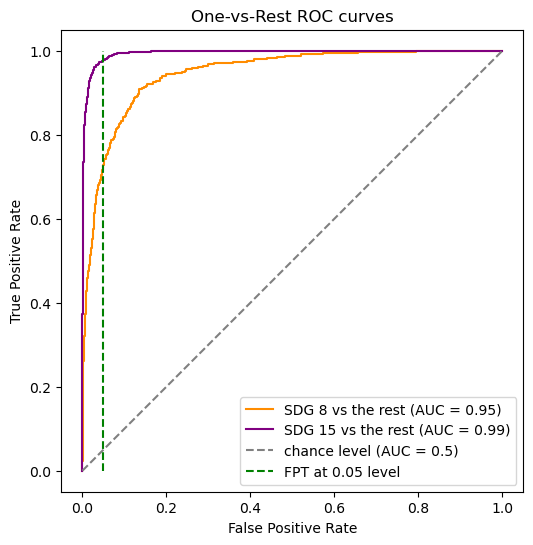
And then the Ridge classifier:
X_train, X_test, y_train, y_test = train_test_split(X, y_onehot, test_size=.33, random_state=0)
ovr_ridge_clf = OneVsRestClassifier(RidgeClassifier(tol=1e-2, solver="sparse_cg")).fit(X_train,y_train)
y_score_ridge = ovr_nb_clf.predict(X_test)
fig, ax = plt.subplots(figsize=(6,6))
class_of_interest = 8 # SDG 8
class_id = np.flatnonzero(label_binarizer.classes_ == class_of_interest)[0]
RocCurveDisplay.from_predictions(
y_onehot_test[:, class_id],
y_score_nb[:, class_id],
name=f"SDG {class_of_interest} vs the rest",
color="darkorange",
ax = ax,
)
class_of_interest = 15
class_id = np.flatnonzero(label_binarizer.classes_ == class_of_interest)[0]
RocCurveDisplay.from_predictions(
y_onehot_test[:, class_id],
y_score_nb[:, class_id],
name=f"SDG {class_of_interest} vs the rest",
color="purple",
ax = ax,
)
plt.plot([0, 1], [0, 1], "--", label="chance level (AUC = 0.5)", color = "grey")
plt.plot([0.05, 0.05], [0, 1], "--", label="FPT at 0.05 level", color = "green")
plt.axis("square")
plt.xlabel("False Positive Rate")
plt.ylabel("True Positive Rate")
plt.title("One-vs-Rest ROC curves")
plt.legend()
plt.show()

Exercise 4
Implementations may vary. One example is given below:
def ClassifyDocs_Advanced(data, classifier_algorithm, params, roc_plot = False, quick_metrics = False):
docs = data.text
categories = data.sdg
X_train, X_test, y_train, y_test = train_test_split(docs, categories, test_size=0.33, random_state=7)
X_train_tfidf_vectorizer = TfidfVectorizer(ngram_range=(1,1), stop_words = "english", min_df=5)
X_train_tfidf_vectorizer.fit(X_train)
X_train_tfidf_vector = X_train_tfidf_vectorizer.transform(X_train)
X_test_tfidf_vector = X_train_tfidf_vectorizer.transform(X_test)
metrics_report = ""
if classifier_algorithm == "mlp":
tfidf_mlp_clf = MLPClassifier(random_state=params[0], max_iter=params[1]).fit(X_train_tfidf_vector, y_train)
y_pred = tfidf_mlp_clf.predict(X_test_tfidf_vector)
tfidf_mlp_clf.score(X_test_tfidf_vector, y_test)
metrics_report = metrics.classification_report(y_test,y_pred)
elif classifier_algorithm == "multinomialNB":
tfidf_multinomialNB_clf = MultinomialNB().fit(X_train_tfidf_vector, y_train)
y_pred = tfidf_multinomialNB_clf.predict(X_test_tfidf_vector)
metrics_report = metrics.classification_report(y_test,y_pred)
elif classifier_algorithm == "ridge":
tfidf_ridge_clf = RidgeClassifier(tol=params[0], solver=params[1])
tfidf_ridge_clf = tfidf_ridge_clf.fit(X_train_tfidf_vector, y_train)
y_pred = tfidf_ridge_clf.predict(X_test_tfidf_vector)
metrics_report = metrics.classification_report(y_test,y_pred)
else:
print("Invalid classifier algorithm")
return 0
if quick_metrics:
#print only accuracy, precision, recall, f1-score from metrics_report
print(metrics_report.split("\n")[0])
else:
print(metrics_report)
if roc_plot:
#plot ROC curve
label_binarizer = LabelBinarizer().fit(y_test)
y_onehot_test = label_binarizer.transform(y_test)
y_score = None
if classifier_algorithm == "mlp":
y_score = tfidf_mlp_clf.predict_proba(X_test_tfidf_vector)
elif classifier_algorithm == "multinomialNB":
y_score = tfidf_multinomialNB_clf.predict_proba(X_test_tfidf_vector)
elif classifier_algorithm == "ridge":
y_score = tfidf_ridge_clf.decision_function(X_test_tfidf_vector)
else:
print("Invalid classifier algorithm")
return 0
fig, ax = plt.subplots(figsize=(6,6))
from matplotlib import cm
colors = list(cm.get_cmap('tab20').colors)
fpr = dict()
tpr = dict()
roc_auc = dict()
for class_id in range(n_classes):
fpr[class_id], tpr[class_id], _ = metrics.roc_curve(y_test[:, class_id], y_score_nb[:, class_id]) # roc_curve works on binary
roc_auc[class_id] = metrics.auc(fpr[class_id], tpr[class_id])
for class_id, color in zip(range(n_classes), colors):
plt.plot(fpr[class_id], tpr[class_id], color=color, lw=1.5,alpha = 1,
label='SDG {0} - {1} (AUC = {2:0.2f})'
''.format(class_id+1, class_names[class_id], roc_auc[class_id]))
plt.plot([0, 1], [0, 1], '--', lw=1, color="lightgrey")
plt.xlim([-0.05, 1.0])
plt.ylim([0.0, 1.05])
plt.xlabel('False Positive Rate')
plt.ylabel('True Positive Rate')
plt.title('ROC for SDG multiclass classifier')
plt.legend(loc="lower right", fontsize=6)
plt.show()
Exercise 5
A point at (1,1) corresponds to a model that predicts everything as a positive, leading to all data points being labeled as positive (so a 100% true and false positive rate). A point at (0,0) corresponds to a model that predicts everything as a negative (so a 0% true and false positive rate). While students do not have to elaborate on this, this hopefully demonstrates that a model with 100% true positive rate or a model with 0% false positive rate is not necessarily a good thing.
14.9.3. Applications#
Exercise 1
Since we are classifying new text data, we do not need to use as many data points for testing purposes. In previous chapters, more testing points are better for model evaluation, while more training data is better to make a more accurate model. In this case, having more training data can make for a more classification of the new texts.
Exercise 2
For these exercises, the training process can take a while, but it is interruptable, as in the solutions given below. The results for the MLP classifier are given as follows:
import requests
from bs4 import BeautifulSoup
url = "https://news.un.org/en/story/2023/07/1138767"
response = requests.get(url)
soup = BeautifulSoup(response.content, "html.parser")
from nltk import sent_tokenize
page_sentences = []
for tag in soup.find_all('p'):
if (len(tag.text)>=30):
sentences = sent_tokenize(tag.text)
page_sentences = page_sentences + sentences
page_sentence_df = pd.DataFrame({"text": page_sentences})
# change this to your own data directory
data_dir = "data/"
# read and preprocess data
text_file_name = "osdg-community-data-v2023-01-01.csv"
text_df = pd.read_csv(data_dir + text_file_name,sep = "\t", quotechar='"')
col_names = text_df.columns.values[0].split('\t')
text_df[col_names] = text_df[text_df.columns.values[0]].apply(lambda x: pd.Series(str(x).split("\t")))
text_df = text_df.astype({'sdg':int, 'labels_negative': int, 'labels_positive':int, 'agreement': float}, copy=True)
text_df.drop(text_df.columns.values[0], axis=1, inplace=True)
text_df = text_df.query("agreement > 0.5 and (labels_positive - labels_negative) > 2")
text_df.reset_index(inplace=True, drop=True)
docs = text_df.text
categories = text_df.sdg
X_train, X_test, y_train, y_test = \
train_test_split(docs, categories, test_size=0.33, random_state=7)
X_train_count_vectorizer = CountVectorizer(ngram_range=(2,2), stop_words = "english" )
X_train_count_vectorizer.fit(X_train)
X_train_count_vector = X_train_count_vectorizer.transform(X_train)
X_test_count_vector = X_train_count_vectorizer.transform(X_test)
count_MLP_clf = MLPClassifier(random_state=1, max_iter=100).fit(X_train_count_vector, y_train)
y_pred = count_MLP_clf.predict(X_test_count_vector)
fig, ax = plt.subplots(figsize=(15, 5))
font = {'family': 'sans-serif', 'weight': 'heavy','size': 7,} # set font for displaying confusion matrix
cm = mpl.colormaps["YlGnBu"] # set the color map for displaying confusion matrix
ConfusionMatrixDisplay.from_predictions(y_test, y_pred, text_kw=font, ax=ax, cmap=cm)
print(metrics.classification_report(y_test,y_pred, digits = 4))
/opt/anaconda3/envs/nlp2/lib/python3.9/site-packages/sklearn/neural_network/_multilayer_perceptron.py:693: UserWarning: Training interrupted by user.
warnings.warn("Training interrupted by user.")
precision recall f1-score support
1 0.7833 0.8191 0.8008 481
2 0.8672 0.7025 0.7762 316
3 0.9139 0.9139 0.9139 674
4 0.9034 0.9316 0.9173 863
5 0.8196 0.9380 0.8748 920
6 0.8554 0.9290 0.8907 465
7 0.6689 0.9384 0.7811 730
8 0.7807 0.4136 0.5407 353
9 0.7925 0.5823 0.6714 328
10 0.7616 0.4492 0.5651 256
11 0.8546 0.7381 0.7921 462
12 0.9007 0.5853 0.7095 217
13 0.7106 0.8646 0.7800 443
14 0.8125 0.8403 0.8262 263
15 0.9174 0.6741 0.7772 313
16 0.9545 0.9716 0.9630 1057
accuracy 0.8326 8141
macro avg 0.8311 0.7682 0.7863 8141
weighted avg 0.8392 0.8326 0.8263 8141
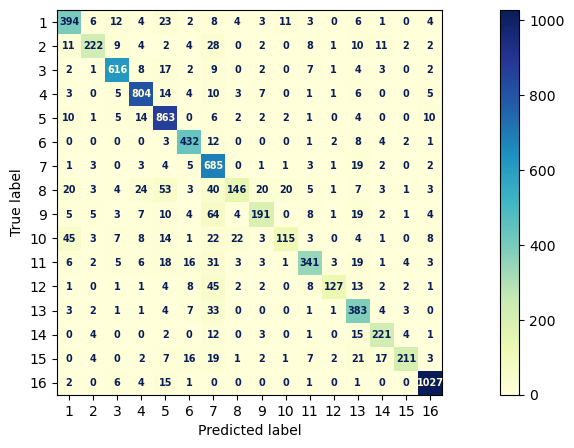
Similarly, the solutions for Ridge Regression work as follows:
count_ridge_clf = RidgeClassifier(tol=1e-2, solver="sparse_cg").fit(X_train_count_vector, y_train)
y_pred = count_ridge_clf.predict(X_test_count_vector)
fig, ax = plt.subplots(figsize=(15, 5))
font = {'family': 'sans-serif', 'weight': 'heavy','size': 7,} # set font for displaying confusion matrix
cm = mpl.colormaps["YlGnBu"] # set the color map for displaying confusion matrix
ConfusionMatrixDisplay.from_predictions(y_test, y_pred, text_kw=font, ax=ax, cmap=cm)
print(metrics.classification_report(y_test,y_pred, digits = 4))
precision recall f1-score support
1 0.7700 0.8004 0.7849 481
2 0.7697 0.7405 0.7548 316
3 0.8640 0.9139 0.8882 674
4 0.7321 0.9502 0.8270 863
5 0.8081 0.9109 0.8564 920
6 0.8803 0.8538 0.8668 465
7 0.8033 0.8616 0.8315 730
8 0.6944 0.4249 0.5272 353
9 0.7094 0.5732 0.6341 328
10 0.7093 0.4766 0.5701 256
11 0.7642 0.7294 0.7464 462
12 0.7925 0.5806 0.6702 217
13 0.8049 0.8104 0.8076 443
14 0.8773 0.7338 0.7992 263
15 0.9057 0.7061 0.7935 313
16 0.9439 0.9555 0.9497 1057
accuracy 0.8138 8141
macro avg 0.8018 0.7514 0.7692 8141
weighted avg 0.8132 0.8138 0.8079 8141
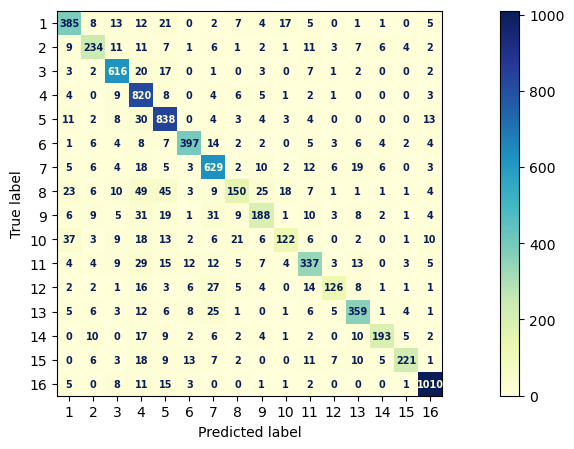
Answers comparing these models may vary, but they are largely similar in their results.
Exercise 3
Answers may vary as to how the students classify the website by reading it; however, goal 8 (Decent work and economic growth) or goal 1 (No poverty) should make the most sense.
To classify this document with Naive Bayes, we do the following:
url = "https://www.rockefellerfoundation.org/our-work/economic-equity/"
response = requests.get(url)
soup = BeautifulSoup(response.content, "html.parser")
page_sentences = []
for tag in soup.find_all('p'):
if (len(tag.text)>=30):
sentences = sent_tokenize(tag.text)
page_sentences = page_sentences + sentences
page_sentence_df = pd.DataFrame({"text": page_sentences})
count_NB_clf = MultinomialNB().fit(X_train_count_vector, y_train)
y_pred = count_NB_clf.predict(X_test_count_vector)
page_count_vector = X_train_count_vectorizer.transform(pd.Series(page_sentence_df.text.str.cat()))
page_pred = count_NB_clf.predict(page_count_vector)
page_pred
array([1])
Exercise 4
High similarity would indicate that more components of the vectors are similar to each other and therefore the vectors have a smaller angle between them. For cosines, we know that smaller angles lead to a higher cosine value, leading to a higher score. So a high score indicates high similarity. Students can also be asked to demonstrate this on a mathematical level, but this is optional.
Exercise 5
The process for generating the similarity matrix uses the same code given in the textbook examples, at least for dataframe generation.
import tensorflow as tf
import tensorflow_hub as hub
# change this to your own embedding directory
embedding_dir = ""
# load the embedding
embed = hub.load(embedding_dir + "universal-sentence-encoder_4")
text_df["embedding"] = list(embed(text_df.text))
def get_sentence_df(text_df):
text_df_sentence = []
text_df_sdg = []
text_df_text_id = []
embedding = []
for (text, sdg, text_id) in iter(zip(text_df.text, text_df.sdg, text_df.text_id)):
temp_sentence = sent_tokenize(text)
text_df_sentence = text_df_sentence + temp_sentence
text_df_sdg = text_df_sdg + [sdg]*len(temp_sentence)
text_df_text_id = text_df_text_id + [text_id]*len(temp_sentence)
embedding = embedding + list(embed(temp_sentence))
sentence_df = pd.DataFrame({"text": text_df_sentence,
"sdg": text_df_sdg,
"text_id": text_df_text_id,
"embedding": embedding})
return sentence_df
sentence_df = get_sentence_df(text_df)
2024-07-15 19:47:39.705699: I tensorflow/core/common_runtime/executor.cc:1197] [/device:CPU:0] (DEBUG INFO) Executor start aborting (this does not indicate an error and you can ignore this message): INVALID_ARGUMENT: You must feed a value for placeholder tensor 'inputs' with dtype string
[[{{node inputs}}]]
To get the first 40 documents, we’ll use similar code but calling a different dataframe:
sns.heatmap(np.array(np.inner(text_df.embedding[:40].tolist(),
text_df.embedding[:40].tolist())))
<Axes: >
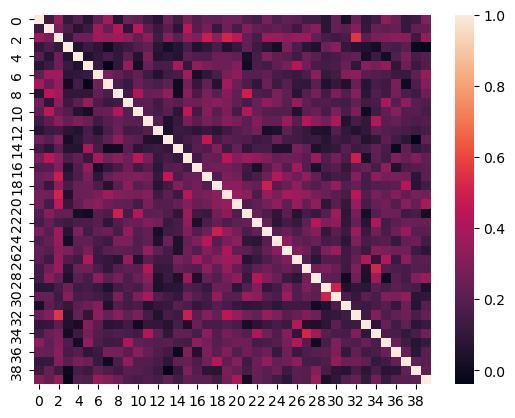
Exercise 6
The code for this is given below. Students may have trouble with runtimes for this due to the number of sentences, in which case you can subset by SDG or position.
sns.heatmap(np.array(np.inner(sentence_df.embedding.tolist(), \
sentence_df.embedding.tolist())))
Exercise 7
def get_most_similar(text_df, sentence, n = 5):
sentence_sim = np.inner(list(text_df.embedding), embed([sentence]))
val = sorted(sentence_sim, reverse=True)[n]
return text_df[sentence_sim > val].text
s = "countries are working hard to save the ocean aminals."
get_most_similar(text_df, sentence = s, n=5)
5780 Oceans cover approximately 71% of the Earth's ...
8186 It puts forward a working definition of the oc...
12106 However, many commercial fish stocks are overf...
15024 Ninety-eight per cent of the area occupied by ...
18113 The top three African countries that have the ...
Name: text, dtype: object
Exercise 8
Students can also take subsets of the sentences, due to the sheer number of sentences present.
#get subset of sentence_df with sdg as 1 or 3
sentence_df_subset = sentence_df[sentence_df.sdg.isin([1,3])]
#make a heatmap
sns.heatmap(np.array(np.inner(sentence_df_subset.embedding.tolist(), \
sentence_df_subset.embedding.tolist())))
<Axes: >
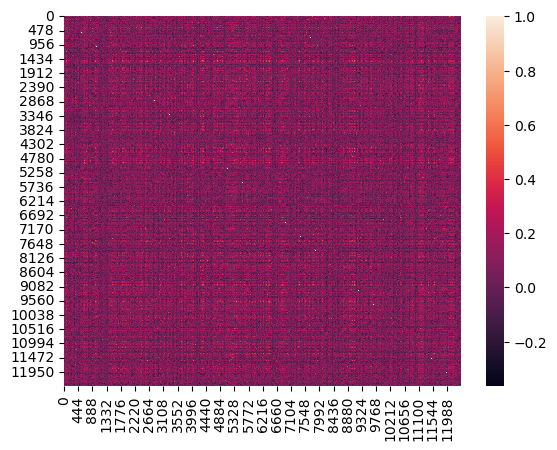
Exercise 9
"""GetMostSimilarToURL(url, text_df, n = 5) takes in a url as a string, parses
it into a single string, and then calls get_most_similar to get the most similar documents."""
def GetMostSimilarToURL(url, text_df, n = 5):
response = requests.get(url)
soup = BeautifulSoup(response.content, "html.parser")
page_sentences = []
for tag in soup.find_all('p'):
if (len(tag.text)>=30):
sentences = sent_tokenize(tag.text)
page_sentences = page_sentences + sentences
#make all the strings in page_sentences into one string
page_string = ' '.join(page_sentences)
#use this to call get_most_similar
return get_most_similar(text_df, page_string, n)
Exercise 10
GetMostSimilarToURL("http://gianttortoise.org/en/beyond-tracking", text_df, n = 5)
4329 A rather large number of species of birds, inv...
4981 In general, neither mechanical nor chemical re...
5758 Assessments now typically involve an “intense ...
10274 The Conservation Banking scheme in the United ...
14146 Local communities and individual farmers prefe...
Name: text, dtype: object
GetMostSimilarToURL("https://www.dhs.gov/blue-campaign/what-human-trafficking", text_df, n = 5)
6677 ABSTRACTThis interpretive policy analysis of A...
10997 The trafficking of persons around the world is...
11409 Human trafficking is a serious global problem ...
22162 Sex trafficking is recognized as a national pr...
24426 International human rights law protects agains...
Name: text, dtype: object
GetMostSimilarToURL("https://www.dol.gov/agencies/odep/program-areas/individuals/older-workers", text_df, n = 5)
1868 In addition, the government has taken some mea...
2098 Although educational attainment has increased ...
18319 More than 280,000 disabled South Africans aged...
20533 Those who have been brought up in poor homes, ...
24499 Such a shift in viewpoint may account for a la...
Name: text, dtype: object
GetMostSimilarToURL("https://michigantoday.umich.edu/2022/08/26/positively-breaking-the-age-code/", text_df, n = 5)
6072 Purpose – The purpose of this paper is to prov...
9517 Eggleston and Fuchs (2012) show that at the be...
13177 The per-capita expenditure is projected accord...
15112 On the other hand, heavy drinking was shown to...
21460 The RAND Future Elderly Model [9] came the clo...
Name: text, dtype: object
Answers may vary as to whether or not the returned documents are most similar. However, students should try and call code such as text_df[6072] so as to read the texts as much as possible before coming to a conclusion.

